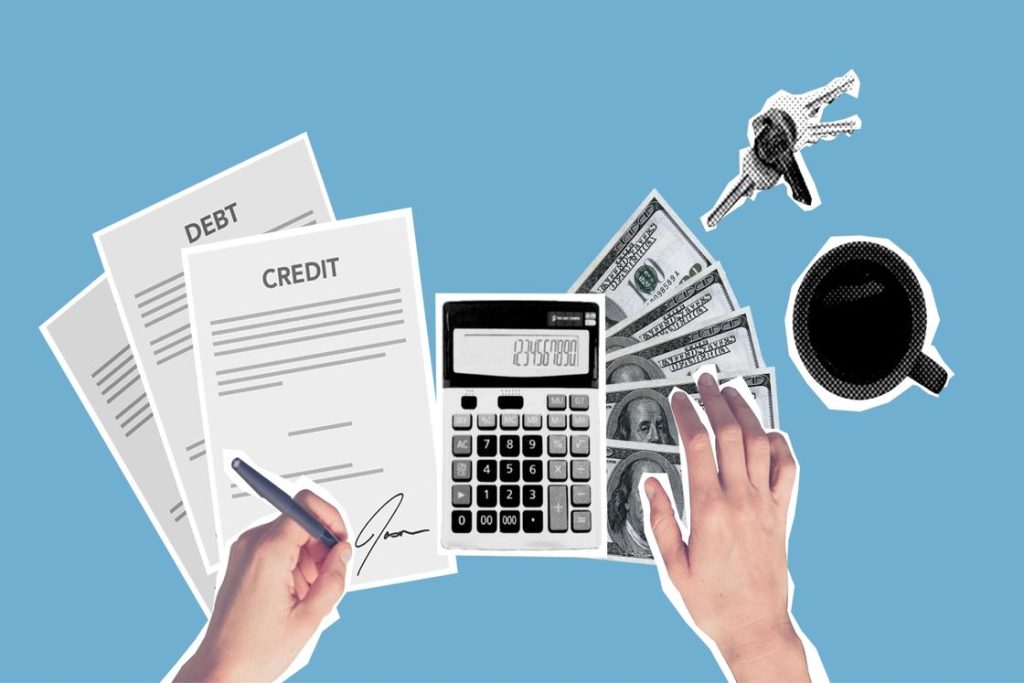A strong credit score unlocks doors: from new homes and cars to job opportunities. Surprisingly, it might even influence cell phone plans or interest rates on loans. Join me as we delve into effective strategies to repair and bolster your credit, ensuring a brighter financial horizon.
How to Repair Your Credit
Assume you take out a home loan for $100,000.00 USD, and the loan agreement comes with a loan term of 30 years at an interest rate of 3.72% (which is the average interest rate in the United States for the year 2020, according to financial analytics company S&P Global), you can expect:

- A monthly loan payment of $461.41 USD per month for the 30-year loan term, with a total loan repayment cost of $166,109.37 USD. This is the principal loan cost of $100k, with an additional $66,109.37 in interest cost.
If I take the exact same situation, but instead increase the interest rate of the average American (3.72%) just a little bit, up 5.48% (which isn’t an unreasonably rare interest rate offering, all things considered), then the same situation outlined above suddenly becomes the following:
- A monthly loan payment of $ 566.53 USD per month for the 30-year loan term, with a total loan repayment cost of $203,952.53 USD. This was the principal loan cost of $100k, with an additional $103,952.53 in interest costs alone.
Between these two situations, there is a monetary cost difference of $37,843.16 for the total loan cost, with a difference of $105.12 per month between the two monthly payment costs. If you take the above examples and instead apply a normal interest rate that someone with a superb credit score could get (2.382%).
They would only be paying $389.01 per month, with just a total loan repayment amount of $140,044.76—a difference of $72.40 per month, and a difference of $26,064.61 in the total loan repayment amount between the person with a superb credit score’s potential interest rate and what the average American’s interest rate is.
The costs of having bad credit can get staggeringly high, which can easily place you under an unfathomable financial burden that can easily have an impact on so many different aspects of your life. Because of how your credit score can really limit what you can and can not do in life, it is very important that you are aware of what your credit score is, what exactly is on your credit score, and how you can begin repairing a bad credit score.
Finding Out Your Credit Score
The first step in repairing your credit is to actually find out what your credit score is. There’s a number of ways that you can find your credit score, through a number of different service providers, which I will detail in this section:
United States Federal law allows each and every American citizen to request a copy of their credit report once per 12 months, at no cost to the requester. These 12 months have to be between your last request and your new request, the annual reports are not provided simply once per year (as in you’re not able to request a free report in December, and then request another free report again in January).
You can additionally request a copy of your credit report either by phone (at 877 322 8228) or by filling and printing out this form which you can mail to:
Annual Credit Report Request Service
P.O. Box 105281
Atlanta, GA 30348-5281
This service is handled by Central Source LLC., which is a joint venture between the three largest credit reporting agencies in the United States (each of which are detailed below) and which was started in cooperation with the Federal Trade Commission (FTC) in order for those three companies to comply with the Federal law known as the Fair and Accurate Credit Transactions Act of 2003 (also called FACT Act or FACTA), which was an amendment to the 1970 Fair Credit Reporting Act;

- Experian: established in 1996, Experian lets users check their credit score as reported by Experian for free. Experian uses the FICO® Score 8 model in order to aggregate and generate an individual’s overall credit score;
- Equifax: originally founded in 1899 as a retail credit company, Equifax is a paid service (which currently costs $19.95 USD at the time of writing, plus tax where applicable) which provides customers with Equifax 3-Bureau credit scores, 3-Bureau credit report monitoring, and Social Security Number (SSN) scanning to prevent identity theft;
- TransUnion: established in 1968, TransUnion offers a paid service (which currently costs $24.95 per month at the time of writing, plus tax where applicable) which provides customers with daily credit score refreshes, up-to-date credit reports daily, 3-Bureau credit monitoring, and identity theft monitoring, and;
Numerous other credit report service providers (both free and premium service providers), such as: Credit Karma, Innovis, Connect (formerly PRBC), myFICO, and ChexSystems, among many others. These credit report service providers might aggregate your credit score using one or multiple reports from the three major CRAs in the United states (Experian, Equifax, or TransUnion), so they might report your credit score as being vastly different when compared to a credit score that is reported by a different provider.
Experian, Equifax, and TransUnion (and similar companies) are what are known as credit rating agencies (which are also referred to simply as CRAs, or as rating services). Credit rating agencies are companies that assign credit ratings to individuals.
These credit ratings are the metric for measuring a debtor’s ability to pay back a given debt by making timely principal and interest payments over the lifespan of the loan term and is what gives a loan provider a key indicator of the likelihood of the loan being defaulted on (the debtor’s failure to pay off the loan).
Experian, Equifax, and TransUnion are the three largest CRAs in the United States and are the companies that worked with the FTC in order to provide American citizens with an annual credit report for free.
Checking Your Credit Report For Errors
After you have found out what your credit score is, the next step would be to make sure that your credit history is up-to-date and correct. By using a credit rating agency’s services (or, preferably, using the services of multiple credit rating agencies, such as obtaining your yearly free credit report provided by Experian, Equifax, and TransUnion), you can get a detailed report on what is impacting your credit score.
This report will provide you with information on the status of any outstanding loans that you have, information about any loans that have already been settled, and information regarding the overall age and health of your credit history.
It is recommended that everyone keep up-to-date on what their credit reports have to say, particularly because sometimes something will be erroneously reported on your credit history, which can be having a negative impact on your credit score, despite the fact that it was incorrectly reported.
According to a report published by the FTC, around 5% of consumers in the United States have at least one error on one (or more) of their three major credit reports, which could lead to them having higher out-of-pocket expenses for obtaining a loan.

By ensuring that your credit report is error-free and that you are aware of what your credit score is, you will be able to be better informed on what your financial obligations could look like if you decide to apply for a new loan now, or sometime in the future.
Experts say that there are some errors that could appear on your credit history that you shouldn’t worry about, as they will not actually have an impact on your credit score, such as: However, there’s a handful of errors that really should be a cause for concern should you see them on your credit history, and you should take the necessary steps required to getting these errors fixed ASAP. The errors you really should look out for are:
Wrong account status, such as a payment being mistakenly reported late even though you paid on time;
Negative reports that are too old to still be reported, because most derogatory marks on your credit history must be removed after seven years has passed from the time they were first reported;
- An ex-spouse being incorrectly listed on a loan, a credit card, or another line of credit;
- Wrong account numbers, or account numbers that are not yours;
- Inaccurate credit limits or wrong loan balances;
- Accounts that you do not recognize, and;
- Addresses being listed on your account that you have never lived at.
There is a section at the end of this article that is designed to help you report any inaccurate credit history information or to dispute marks on your credit history that you feel were made in error.
How Keeping Up-To-Date With Your Credit Score Also Protects Your Credit Score
Another important reason that you should be aware of what your credit report says about your credit history is that, according to a 2019 identity fraud study performed by Javelin Strategy & Research, there were more than 14.4 million victims of identity theft in the United States in 2018 alone.
According to the same study, 3.3 million people out of the 14.4 million total victims had unreimbursed personal expenses in 2018 due to being responsible for a portion of the liability of the fraud that was committed against them. Moreover, these 14.4 million victims’ out-of-pocket costs due to the fraud totaled more than $1.7 billion USD.
What Affects Your Credit Score
So, what actually has an effect on what credit score is? What is being used to determine the risk of offering a line of credit to a particular consumer? There are a number of factors that play a role in calculating what your credit score should be. Each of these factors can have different amounts of impact on your credit score, but each factor is still overall important to take into consideration. The most important factors that affect your credit score are:

- Your payment agreement history;
- How much debt you have in total;
- The age of your credit history;
- New credit reports made to your credit history, and;
- Credit utilization and diversity.
It is a very common misconception that other financial factors such as your age, your employment status, the amount of assets that you might own, and your income, among other related factors, have an influence on your credit score. None of these factors actually do, however. Nothing outside of the five factors that are used in determining your FICO score (payment history, the burden of debt, credit history age, credit utilization, and newly made “hard” credit inquiries.
Despite none of these other factors playing a role in determining your credit score, it does not prevent lenders from asking and accounting for these factors when making a decision as to whether or not to extend a loan agreement and using these additional factors in order to determine the loan agreement’s terms.
As for the five factors that do play a role in determining your credit score, I will attempt to provide you with a strong understanding of exactly what these credit score affecting factors are, and how they play a role in determining what your credit score is in the next five sections of this article.
Credit scores from 740 and 799 are “Very Good”, and those that fall in the 800 to 850 range is “Excellent”.
What Is FICO, the Credit Scoring System?
Now that I have covered the basics of finding out your credit score, and how to ensure that your credit history is up-to-date and is free of any incorrect information in addition to explaining why keeping track of what is on your credit report can be important, I should take a deeper look into how exactly your credit score is actually determined.
Experian, Equifax, and TransUnion use what is known as The FICO scoring method in order to assign each consumer with a credit score. The FICO model is used by the vast majority of banks and credit grantors in order to assess the risk of giving out a loan to an individual.
The FICO scoring model was first introduced in 1989 by FICO, who were operating at that time under the name of Fair, Isaac, and Company, which is where the name originally came from. The FICO score assigns each credit affecting factor with a specific weight (percentage amount) based on what the model considers to be the most important factors in assigning a consumer with their specific credit score. The FICO scoring systems breaks down in the following way:
- Payment history (whether or not you have consistently paid loans off on time / made timely loan payments): 35%;
- Burden of debt (how much debt you have in total): 30%;
- Credit history age (how long have you been paying on one or more loans): 15%;
- New credit inquiries (recent “hard” credit inquiries, or “hard pulls”): 10%, and;
- Credit utilization / portfolio diversity (which types of credit are being used): 10%
Not every credit rating agency uses The FICO scoring system, and not every credit affecting factor is reported to all credit rating agencies (even among CRAs that use The FICO scoring system, and even among just the “Big Three” CRAs), which can—and often does—lead to credit reports being different for the same consumer.

Because a consumer’s credit history file may contain differences in the information that has been reported by each of the three bureaus, a consumer’s FICO score can vary wildly depending on which bureau is being checked in with by a loan provider, which is why it’s important to know roughly what range your credit score is in among the “Big Three” CRAs, and even why it can be important to know which agency a loan provider checks a consumer’s credit history with, so you will know what to expect when they run a credit check.
The FICO credit score has a scoring range from a minimum of 300 up to a maximum of 850, and according to FICO in 2019: 59% of people in the United States had a FICO credit score that was between 700 and 850, 45% of them had a score that was between 740 and 850, and only 1.2% of Americans held a perfect FICO score of 850.
The “Big Three” credit reporting agencies each have their own views on what a specific credit score should be classified within a range:
Experian classifies a FICO credit score that is lower than 580 to be “Very Poor”, a credit score that is between 580 and 669 as “Fair”, a score that is from 670 to 739 as “Good”, 740 to 799 is “Very Good”, and finally 800 to 850 are “Exceptional” credit scores.
Equifax considers a FICO credit score that is lower than 580 as “Poor”, credit scores in the 580 to 669 range is “Fair”, 670 to 739 is “Good”, credit scores from 740 and 799 are “Very Good”, and those that fall in the 800 to 850 range is “Excellent”. Equifax considers individuals with a FICO score that is below 670 to be “subprime borrowers”.
Subprime lending (which is also sometimes referred to as near-prime, subpar, non-prime, and second-chance lending) is a type of loan that is generally offered to people who may have difficulty in maintaining a normal loan agreement’s repayment schedule.
TransUnion uses the VantageScore 3.0 model in order to classify credit score ranges. Credit scores that fall between 658 and 719 receive a “C” rating, scores that are between 720 and 780 are within the “B” rating range, and scores that fall within the range of 787 to the perfect credit score of 850 are considered to have an “A” rating.
How FICO’s Five Categories Affect You
Now that I have covered how FICO calculates what your credit score should be, and how the “Big Three” credit reporting agencies use this FICO information, I will next be detailing how exactly each of the five categories that FICO looks at (payment history, the burden of debt, the age of your credit history, the number of hard inquiries being made against your credit history, and your credit history portfolio’s loan diversity) actually have an impact on your credit score.
I feel it is important to first explain how each of these categories will impact your credit score before outlining what you can do to mitigate (or hopefully prevent) any negative effects that a particular occurrence can have on your financial stability and your ability to take out a new line of credit in the future.
Remarks that have been reported to a credit reporting agency can take a long time before they stop having an effect on your credit score
How Your Payment History Affects Your Credit Score
This can also be described as your “presence” in terms of your payment history. What is being looked at for this specific credit affecting factor is whether or not you have any derogatory information present in your credit history.
Things such as declaring bankruptcy, being subjected to liens, the presence of judgments being made, the presence of settlements, the presence of charge-offs (or write-offs, where the loan provider has “given up” on collecting what is owed), whether the individual has ever had something repossessed from them, whether the individual has ever been foreclosed on, and if the consumer has ever made a late payment on a loan agreement.
Remarks that have been reported to a credit reporting agency can take a long time before they stop having an effect on your credit score, this applies to both positive remarks and negative remarks.
- Missed payments: up to 7 years;
- Student loan delinquency: up to 7 years;
- Account charged off or account sent to collections: up to 7 years;
- Repossession or foreclosure: up to 7 years;
- Filing for bankruptcy: up to 7 years for Chapter 13, and up to 10 years for Chapter 11 and Chapter 7;
- Closed accounts paid as agreed: up to 10 years, and;
- Active accounts paid as agreed: Remains on your report while “Active”

In addition to the situations that you would assume have an impact on your payment history, there is another situation that can require you to make a payment that can have a negative impact on your credit score, regardless of whether that payment was made on time and has been paid off in full.
Any money that was—or currently is—owed to another entity (whether that entity is another person, a business, or the government) because of a court judgment, a tax lien, or because of a similar reason, carries its own negative penalty to your credit score that is independent of any other reports to your payment history, especially if this judgment was made recently.
Unfortunately, there is no “easy” way out when it comes to fixing poor payment history. Filing for bankruptcy does not remove negative reports in your credit history. If and when all of your debts have been discharged in bankruptcy, the balances for these debts will all be reported as $0 USD, but the accounts will still remain on your credit report. Any accounts that were included in your bankruptcy filing will be noted as such.
Closing an account also won’t eliminate any reports of payment delinquency. If you were to close an account that has a past-due balance, your payment will still be reported as being delinquent until you are able to catch up on the missed payments.
Paying a delinquent balance off also doesn’t erase the negative mark in your credit history. Once you have paid the balance off, the account’s status will change to “Current” or to “OK” as long as the account hasn’t been charged-off or been sent to collections. Charge-offs and accounts that have been sent to collections will continue to be reported that way, even after you have paid the balance.
How Your Debt Burden Affects Your Credit Score
This category considers a number of debt specific measurements. According to the FICO scoring system, there are five different metrics that should be looked at and accounted for in the debt category, which are:
The amount owed in total across all of your accounts: this is the total balance that is owed across all loans and credits;
The amount that you owe on different types of accounts: this looks at how much is owed for all specific types of accounts, such as the total that is owed across all credit cards, the total that is owed across all auto loans, et cetera;
How many of your accounts in total have balances: this takes into consideration how many “active” loans and credits you currently have, as having too many accounts with balances could indicate that the consumer is financially overextended, making them a riskier loan seeker;
Credit utilization ratio on all of your revolving credit accounts: this looks at, for example, how much of the credit limit on something such as a credit card is being used. If you have almost hit the limit on your credit cards, then FICO considers you to be a higher risk, and;
How much of the installment loan amount is still owed in comparison with the original loan amounts across all accounts: this category looks at how much of the original installment loan in total is still left to be paid off. So, for example, if you took out a line of credit for $100,000 USD, and you have only paid $10,000 towards this hypothetical loan, then you still owe 90% of the total loan amount.
Still owing 90% of a single loan does not look good on a credit report, nor does it instill in a lender any confidence that you are a low-risk borrower. However, if instead of paying $10,000 towards this $100,000 loan, you have actually paid off $80,000, then this would have a positive impact on your credit score, as you currently only owe 20% of the total loan.

How Your Credit History Age Affects Your Credit Score
As a credit history ages, it will often have a positive impact on a consumer’s FICO score. There are two metrics that FICO takes into consideration in regards to this category: the average age of the accounts on the credit report and the age of the oldest account.
By having more accounts that are listed on your credit report that are “mature” credit reports and by having at least one account that is (preferably) multiple years old, you will be more likely to have a better credit score because FICO considers these two metrics as good indicators that you are more financially stable and are more likely to pay off a loan agreement in full, which often takes a number of years to do.
How New Credit Report Inquiries Affect Your Credit Score
These new credit inquiries, which are commonly known as “hard” credit inquiries, or “hard pulls,” are inquiries that occur when a consumer applies for a new credit card or for a new loan, regardless of whether the loan being requested is revolving credit or installment credit.
Each hard credit inquiry will have a negative impact on your credit score, except in certain situations that FICO accounts for, such as consumers that are “rate shopping” (which is to say, they are shopping around in order to try and get the best rate possible) for a mortgage loan, an auto loan, or even a student loan over a short period of time will likely not experience any meaningful negative impact to their credit score.
The period of time that these hard credit inquiries can be made from multiple sources is somewhere between two weeks up to 45 days, depending on the generation of (or the version of) the FICO score that is being used. The FICO scoring model considers these types of hard inquiries that are made within this short period of time as being only one hard inquiry in total, as opposed to numerous separate hard credit pulls.
Credit inquiries that are made by the consumer (such as when using a credit reporting agency’s services), that are made by an employer (for employee verification purposes), or that are made by companies that are initiating pre-screened offers of lines of credit or insurance are what are all known as “soft inquiries” or “soft” credit pulls.
Soft credit inquiries do not have any impact on a credit score, as FICO does not even consider them when determining your credit score. These soft credit pulls do not even appear on the credit reports that are used by lenders, as they only show up on personal reports.
All credit inquiries (soft and hard) are both recorded and displayed on personal credit reports for two years in total, however, any hard credit inquiries that have been made will have no effect on a credit score after the first year, due to the fact that FICO’s scoring system will ignore them after 12 months have passed since the credit inquiry was made.
How Credit Utilization and the Diversity of Your Credit Portfolio Affects Your Credit Score
By having a variety of different credit types present in your credit history, you can possibly receive the benefit of having a higher FICO credit score. This is because of how the credit scoring system assesses the overall diversity of your credit portfolio, and because of how FICO makes a determination based on how you’re utilizing your different credit sources.
FICO has determined that this is an important factor when determining a credit score because it shows that the consumer is able to be financially flexible enough to pay off a variety of different loan agreements, many of which are likely to have different payment requirements.
The more financially flexible a consumer is, the more likely they will be able to take on a new loan agreement and pay off a loan agreement, without suddenly realizing that they have overextended themselves financially without realizing it until it is too late, and they are now more likely to default on one or more loan agreements.
In order to help you understand the different types of credit that FICO considers when determining your credit score, I will go over the different types of lines of credit that are commonly used in the next section.

Understanding the Different Types of Credit that Can Add Diversity to Your Credit History
There are a variety of different types of commonly used credit that can be taken on by an individual, with each type of credit agreement differing in a variety of ways. These different common credit types are:
- Installment Credit: this is a type of credit that involves loans where a fixed monetary amount was given, in exchange for an agreement made by the debtee to make a fixed monthly payment which is put towards the overall loan balance until the loan has been fully paid off. Types of loans that are made on installment credits include: student loans, personal loans, and most mortgages;
- Revolving Credit: this is a type of credit that is usually associated with credit card debt, but can also include certain types of home equity loans. Revolving credit has a hard credit limit, and requires the debtee to make minimum monthly payments at the very least, with these monthly payments being based on how much credit has been used. Revolving credit can (and typically does) fluctuate, and it doesn’t usually have a fixed credit term;
- Consumer Finance Loans: are types of credits that are also known as alternative financial service (AFS) credits. These types of credits include payday loans, rent-to-own loan agreements, lines of credit issued by pawnshops, refund anticipation loans, and even some subprime mortgage loans and car title loans fall under this category;
- Rent-to-Own Leases: are types of leases that are generally used for mid- to high-cost products, but are not necessarily just for automobiles and homes. Many typical rent-to-own leases are for products such as furniture, home appliances, and various electronics, and;
- Mortgage Loans: are a loan type that is used either by purchasers of real estate (real property, realty, or immovable property) in order to raise the funds that are necessary in order to make the purchase, or that is used by existing property owners in order to raise funds for whatever personal reason that they might have by putting a lien (a type of security interest that is granted over the property in order to secure the payment of a debt) on a property that they are have already mortgaged. Mortgage loans are “secured” on the loan borrower’s property through a legal process which is known as “mortgage origination”. This process simply means that a legal mechanism or failsafe was put into place that allows the loan provider to take possession (through a foreclosure or through repossession) and then sell the secured property in order to recoup the cost of the loan in any instance where the borrower defaults on the loan or otherwise breaks the terms of agreement on the loan.
How to “Fix” Factors That Negatively Impact Your Credit Score
There are a couple of different steps that you can take in order to mitigate a FICO-affecting factor’s effect on your credit score, in addition to many more steps that you can take in order to avoid being negatively impacted by one of these factors that FICO take into consideration when calculating your credit score, to begin with.
In the next couple of sections, I will provide you with some tips on how you can try and mitigate any negative impacts to your credit score—where possible—and I will also provide you with some information that can help you to avoid any potential future occurrences from lowering your credit score.
Credit Payment History
Improving your credit payment history is often difficult, and rarely will you find success depending on your specific circumstances, but there are a couple of things that you can do that might help
First off, if you have received a missed payment remark, or another negative remark, as the result of an error, you should attempt to dispute it. If you do find an error in your credit history that is being reported by one or more of the “Big Three” credit reporting agencies, I have a section near the bottom of this article that explains how to dispute a negative remark;
You can attempt to obtain a “Goodwill Letter” from the creditor that you have missed a payment with. Oftentimes creditors will refuse to provide these unless you have a long history of on-time payments with them as it is. A Goodwill Letter is a request that they remove the missed payment report, and is an excellent way to explain the circumstances that led to you missing an agreed payment.
Because the Goodwill Letter is being written in good faith, it also shows to the creditor that you are taking responsibility for the mistake that you made, or for the situation as a whole, which can help to sway them into being more empathetic with you. The main thing to remember is that most creditors and people that are employed by the creditor that you’ll likely be dealing with on a regular basis are regular people that can be very understanding of the circumstances and of your current financial situation;
Other than attempting to appeal to the creditor to have the negative remark retracted, the only other real option is to wait for these negative remarks on your report to “fall off” after the period of time that it normally takes (around seven years) has passed since the report was initially made with the credit reporting agency or agencies.
Obviously, the best path to take for this specific FICO category would be to not get into a situation that is likely to cause you to become financially overextended. As explained by the Consumer Financial Protection Bureau (the CFPB)—which is the agency of the United States government that is responsible for consumer protection in the financial sector—it is important to be aware of your debt-to-income (DTI) ratio and to try and aim for a 43% (or lower, preferably) debt-to-income ratio.
In order to calculate your debt-to-income ratio, you first need to add up all of your monthly debt payments (all of your monthly expenses), and then divide them by your gross monthly income (income that was earned before your taxes and other deductions were taken out).
So, for example, if you pay $1,000 USD per month on your mortgage loan, another $400 a month for an auto loan, and then finally another $200 a month for the rest of your debts, then your monthly debt payments are $1,600 USD. In this example your gross monthly income is $3,000 USD, then your debt-to-income ratio is 53.33% because your monthly debt costs take up 53.33% out of your gross monthly income.
Consumers with higher debt-to-income ratios are more likely to find themselves in a situation where they are struggling to make their monthly payments. The 43% debt-to-income ratio is important because—in most cases in the United States—that is the highest ratio that a borrower can have and still be able to get a Qualified Mortgage loan from a lender.
At the core of maintaining a positive credit payment history is to try and ensure that you’re able to comfortably pay all of your monthly debts, while still being able to try and account for any unforeseeable circumstances that might arise in the future.
Burden of Debt
There are a couple of different steps that you can take in order to make the categories that fall under your burden of debt be more appealing to FICO’s scoring system, such as:

- Because FICO takes your credit utilization ratio into account when determining your credit score, getting a credit card with a higher limit than what you feel you will need can be a smart decision, as having a larger gap between how much you have put on your credit card and how much you can put on your credit card looks better than being near your credit card’s spending limit. The credit utilization ratio is the amount owed divided by the amount extended by the creditor, with a lower credit utilization ratio being better for your credit score;
- The number of accounts with balances that you have on your credit report can have a negative impact on your overall credit score, but you can help to fix this problem by targeting the accounts that you have that will take less money to pay off fully, and paying a little extra on those each month if you were only paying the monthly minimum towards those accounts. If you were already paying more than the monthly minimum, you can still try and shuffle your finances around so you can pay even more towards these accounts each month. The sooner you pay them off, the sooner you will have one less “active account paid as agreed” and one more “closed account paid as agreed” being reported;
- When targeting the debts that you will be able to pay off the fastest, you further want to target those debts that have the highest bill-to-balance ratio. This simply means paying more towards the debts that will reduce your debt-to-income ratio with the least amount of money needing to be paid towards it. It’s a “more bang for your buck” scenario;
- Try and avoid taking on more debt, if possible. If you take on unnecessary loans, then you will just be fighting against yourself when it comes to lowering your debt-to-income ratio;
- Use balance transfers to your advantage. If you can shift your debt from a source (such as a credit card) with a higher interest rate to a source (such as a different credit card) that has a lower interest rate, this can help you to balance your budget in a more efficient manner, and;
- Finally, you can also try and restructure your debt by refinancing your debt with a new lender, such as one that might be able to provide you with an overall lower interest rate, or one that can give you a longer payment agreement, which can help to lower your monthly debt costs. Lenders can refinance your debt by negotiating with the original lenders and buying out your loan agreement for less than what you still owe on it, allowing them to finance it back to you at a discount while they are still able to make a profit off of the loan.
Credit History Age
There’s really nothing that can be done about this category now, other than opening up a line of credit as soon as possible if you have not already done so. It is not too early to open a line of credit for a teenager or help a sibling or other younger family member to get a jump start on this. One of the best ways to do this is by getting a secured line of credit through a lender that has experience working with those that have little or no credit history.
These secured lines of credit can be pre-loaded with, as an example, your bill money or just some spending money each month. By using a secured line of credit, as opposed to just paying with cash, you can slowly begin building up your credit history.
There are many specialized credit cards for those with bad credit, students, and frequent travelers, in addition to those with little or no credit history.
New Credit Inquiries
There are a few tips that I can give for mitigating the damage that hard credit inquiries can do to your credit score:
- Do not apply for loans unless it is absolutely necessary. Frivolously applying for loans will cause the lender to put a hard credit inquiry on your credit history, which will bring your credit score down a little;
- If you are trying to take out a necessary loan or are having a necessary credit inquiry being made (such as a land loan, an auto loan, or the credit inquiries that occur when applying for a new utility provider), you can and should shop around to try and get the best interest rate and loan agreement that you possibly can. Multiple hard credit inquiries that are made within a span of two weeks to around 45 days for these kinds of loan requests will generally all just count as one hard credit inquiry in total, as each individual hard credit inquiry won’t actually be counted by FICO’s scoring algorithm, and;
- Plan before even starting to apply for a new loan. Find out as much as possible about any and all new lenders that you might be attempting to get a loan from. Find out if the hard inquiries that they will make against your credit history can be counted as a single hit if you end up applying for a loan from multiple lenders. Find out if you know anyone that has any experience with a specific lender, or ask around online. See how other people feel about a lender. Try and find out as much information about a lender as possible before you ever request a loan quote from them. By doing this, you can potentially cut down on the number of loans that you apply for, find a lender that will work with you, and ensure that your credit history will not be getting hit with multiple hard credit checks as opposed to just having one hard credit check be counted against you.
The fewer hard credit inquiries that are made outside of the two-week to 45-day window, the better. These hard credit inquiries do fall off after about a year, at which point they will no longer have an effect on your credit score.
In addition to not applying for unnecessary loans, by limiting the amount of loans that you apply to within the time frame where all of the hard credit pulls will be counted as a single inquiry, and by limiting the amount of loans that you apply to overall in the span of 12 months, you will be able to help your credit score stay healthy.
Credit Utilization and Credit Portfolio Diversity
The best way to use this category to your advantage, and have it provide a positive (or at the very least a neutral) effect on your credit score is to take out a variety of different types of lines of credit, assuming that you can reasonably pay all the debts off on time.
If taking on a small loan that is a different line of credit to those that you already have in your credit history will not be a burden to you financially, and will not increase your debt-to-income ratio % to an unsafe range, then it can be well worth looking into.
Some different lines of credit outside of your mortgage or auto loan that you could think about taking out include the following:
- Bank-issued credit cards;
- Retail credit cards (such as Target’s RedCard, a Lowe’s credit card, or the Amazon.com Store Card, among others);
- Gas station reward credit cards (such as Shell’s Fuel Card or the Circle K Fleet Card ;
- Furniture, appliances, or electronics rental agreements, and;
- Other small rent-to-own agreements.
Additionally, it might be worth keeping a credit card that you have paid off open instead of closing the account down because it will add to not only your credit portfolio diversity but also to your credit utilization ratio. FICO gives this category a weight of just 10%, and the scoring system does not consider this to be a very important category.
Having good credit portfolio diversity absolutely does have a positive impact on your credit score, but it is not worth risking overextending yourself financially, as that can lead to you defaulting on your loan agreements, and FICO considers your credit payment history to be significantly more important (at 35%) than your credit portfolio diversity (which is just at 10%).
However, if you can supplement the diversity of your credit history without it being a risky action, then it can be a really good way to increase your overall credit score.

The Process of Disputing Credit Report Errors
All three credit reporting agencies (Equifax, Experian, and TransUnion) each have their own dispute processes which can be done either online, by mail, or on the phone. Handling a dispute online is going to be by far the fastest method to resolve any credit report errors, but there is still the option to handle the dispute process by mail or by phone.
Here’s the necessary contact information for disputing a mark on your credit report for each of the “Big Three” CRAs:
Equifax
You can write to Equifax, P.O. Box 740256, Atlanta, GA 30374-0256.
Or call Equifax customer support at 866 349 5191 and follow the automated prompts to speak to a customer support representative.
Experian
You can write to Experian National Consumer Assistance Center, P.O. Box 4500, Allen, TX 75013.
Or call Experian customer support at 866 200 6020 to see if your dispute can be resolved by phone.
TransUnion:
You can write to TransUnion LLC, Consumer Dispute Center, P.O. Box 2000, Chester, PA 19016.
Or call TransUnion customer support at 800 916 8800, and speak to a customer support representative. When you call TransUnion customer support, make sure that you have a copy of your TransUnion credit report on hand in order to make a dispute claim.
In order to make your claim that an error has been made on your credit history, you should gather as many supporting documents as possible, such as copies of your credit card statements, copies of your bank statements, and copies of your loan agreement documents.
When you file a credit report dispute, the Federal Trade Commission suggests that you also inform the company that provided the erroneous data to the credit bureaus, such as the reporting bank, lender, or credit card issuer.
The FTC suggests that you inform them in writing by using their publicly provided contact information. Most of the time this contact information can be found listed on your credit report, but for some companies, you may need to contact them directly and request an address that you can use.
The FTC has a sample letter for disputing a credit report error that you can fill out and use, or that can be used as an example of how to format your own letter.
These sources of reported credit information are what are known as furnishers. By notifying the data furnisher that made the report in error, you may be able to have them voluntarily proactively stop reporting the inaccurate information to the credit bureau, although this is not something that they are actually obligated to do just by written request.
The FTC does note that if the provider continues to report the item that you have disputed with them to a credit reporting company, they are legally required to notify the credit reporting company that you have opened a dispute with what they are reporting. If it turns out that your dispute was correct and something was being reported in error, then the information provider must inform the credit reporting company to update and/or delete the incorrectly reported item.
If, after you have disputed a reported item, the data furnisher denies any wrongdoing and the credit reporting agency does not remove the disputed item, you can take the complaint higher, by contacting the Consumer Financial Protection Bureau (CFPB) and providing them with the information regarding what you’re disputing and providing them with the copies of the documents that prove your case.
After opening a dispute with the CFPB, you will be able to follow the progress of your case via email updates, or by logging into the account you made on their website when you opened a complaint ticket with them.
